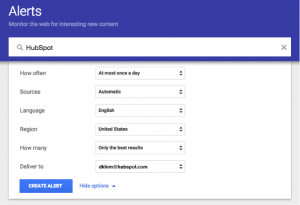Spam. Gross.

Once upon a time, this odd sounding word conjured up images of a salty canned meat product that gained popularity during World War II. Later, it became the subject of an oft quoted Monty Python sketch that poked fun at the unavoidable nature of the so-called ‘mystery meat.’
Following on from the ‘unavoidable’ theme established in that now classic comedy sketch, the word ‘Spam’ is now most widely used to described unwanted electronic communications that arrive uninvited in our computers or mobile phones. Most everyone in this day and age has had to deal with the inconvenience of spam appearing in our email inboxes, on our cell phones, and in the comments sections of some of our favorite websites and blogs.
For most of us, combating spam is as simple as adjusting the spam filters on our various electronic devices to blacklist incoming communications from unfamiliar sources.
For individuals or companies hosting web forums or blogs however, comment spam is often a much more troublesome problem.
Blog Comment Spam: The Web’s Door-To-Door Salesman
First off, unwanted messages of any kind can create a negative user experience for those legitimate visitors to your site seeking a balanced conversation free of invasive and aggressive spam.

Most spam is intended to aggressively sell a particular product or service, and more often than not, the product being aggressively pitched is in no way related to the actual discussion at hand. It’s literally the Internet equivalent of a pushy door-to-door salesman jamming his foot in your doorway. No one wants that snake-oil-salesman in their homes, and similarly, no one enjoys the unsolicited sales pitches cropping up in otherwise enjoyable web forums and comment sections. Blog comment spam can seriously impair the performance of a website which is the reason it’s become a favorite tactic of unscrupulous hackers.
By flooding the comments section of those blogs that are inadequately prepared to filter or block unwanted spam, hackers can take an entire website or network of websites offline. This is known in the Network Security field as a Denial-of-Service attack and unfortunately, it is an all too common threat for those popular but unsecured websites that present an all too inviting target to these nefarious hackers looking to extort money from profitable site owners.
Given the negative impact on the user experience for our site visitors, and the legitimate security threat posed by hackers, it is obviously crucial to find out how to stop getting spam in the most effective and sustainable manner.
How To Stop Getting Spam – 4 Effective Tactics
1) Comment Moderation
In the early days of the Internet as message boards, web forums and blog communities became established and grew in popularity, and the most common technique for preventing spam messages was Comment Moderation.

A basic, hands-on approach for combating blog comment spam, moderation relies on the ongoing monitoring of all messages being posted by tireless site moderators, tasked with spotting and then quickly removing unwanted spam messages. In some drastic cases, sites have taken an even heavier handed approach to moderation, essentially placing all incoming comments in a holding pattern awaiting direct review and approval before final posting to the website.
For those websites willing to commit the necessary human resources to comment moderation, it can be an effective tactic for blocking unwanted spam.
Effective moderators can be extremely useful in helping to grow and preserve a website community. Skilled moderators keep conversations on topic, police against bullying or trolling behaviours, and generally maintain a civil code of conduct amongst the community even when discussing controversial or potentially divisive topics.
The obvious downsides are costs and lack of scalability. Human moderation requires 24/7 staffing and as the website’s community grows exponentially, so too does the need for additional moderators. For this reason, Comment Moderation is no longer the most common or preferred method used to eliminate blog comment spam outside those companies with the budget or mandate to do so.
2) Captcha Them If You Can

Over the last decade, various tools and technologies have been developed and implemented as site owners continue in their never ending search to determine how to stop getting spam. Perhaps the most popular of these tools is the now ubiquitous ‘Captcha’ tool, that effectively blocks unwanted blog comment spam by forcing direct human interaction with the website before a comment is actually submitted.
If you’ve ever been prompted to type in a sequence of numbers and letters, or even just a simple phrase (as depicted in an accompanying image)—before you’re allowed to submit your desired comment—then you’re familiar with the Captcha tool.
Because of its requirement for direct human interaction, Captcha is particularly effective in blocking automated spam, spam transmitted and published by programmed ‘bots’ typically acting in the service of cyber hackers. Because of its automated nature, hackers can funnel huge volumes of unwanted spam into the comments sections of those blogs unprepared for such a situation.
As a result, Captcha is not a particularly effective method for eliminating blog comment spam posted by an actual human being, but it is definitely an effective arrow in the quiver for site owners hoping to block automated spam attacks.
3) User Registration
So, with Comment Registration typically seen as too expensive or impractical and filter/tool solutions such as Captcha ineffective in preventing spam posted by actual living, breathing human beings, what’s a popular blog site owner to do in their quest to eliminate blog comment spam?
For many, the solution to this problem is User Registration.
By encouraging your site visitors to register with your website, submitting their personal information in return for a user profile, membership privileges, and a secure login, surely this will eliminate any unwanted spam messages?
After all, who’s going to spam a community after they’ve gone to all the trouble of becoming a member of that community? For that reason alone, User Registration has to be the best method to stop getting spam in the comments section of your website, right?
The short answer is yes and no.
Like Captcha, user registration is an effective process for eliminated automated spam messages. Registering as a member of a website does require direct human interaction which helps to block those pesky spam bots.
In addition, facilitating a registration/membership model on your website will help to instill a sense of community thus encouraging your membership to moderate themselves and each other to discourage unwanted blog comment spam.
But what do you do when a person has become a member with the sole intention of spamming the website and has little interest in maintaining long-term standing in the community?
For websites with large and loyal audiences, this is a very real problem. The very nature of Internet communities, particularly those that align members along common interests, makes them convenient and inviting targets for unethical businesses desperate to pitch their wares to a captive audience.
As a result, User Registration comes very close to solving almost all of the issues related to unwanted blog comment spam. The lone weakness is the lack of a reputation component to penalize those members that simply don’t care about their standing in the community.
Which brings us to the final piece of the puzzle – Social Login.
4) Social Login – The Ultimate Weapon Against Unwanted Spam
Social Login is essentially a User Registration model, but one with massive advantages, particularly for those sites keen to eliminated unwanted spam messages.
Social Login enables users to login to your website or blog community by virtue of an existing profile from one of their favorite social media sites (e.g. Facebook, Twitter, Pinterest, Instagram, etc.). By importing an existing social media profile, your site users are spared the inconvenience of registering and creating a new membership profile to access your site. This makes Social Login the quickest, easiest and most convenient method of user registration imaginable.
In addition, Social Logins retain all of the inherent reputation components associated with existing social media profiles. In other words, anything that a person would be reluctant to do with their existing social media account where friends and family interact, they will also be reluctant to do on a website using Social Login.
How To Stop Getting Spam: Staying One Step Ahead
There is another process for preventing spam, but the relative ineffectiveness of this method makes it one not worth discussing in great detail. With that being said, a quick examination of it speaks to the importance of staying one step ahead of the spammers.
Spam filters within email and other wireless communications devices are designed with the express purpose of detecting and preventing delivery of spam. These filters do so by cross-referencing incoming sender domains vs. spam ‘blacklists’ to establish if the communication is originating from a confirmed spammer.
Most of us have used such tools and are thus aware of their hit and miss effectiveness. Typically effective at the start, such filters rapidly becoming increasingly porous as spammers reroute their communications from domains not on the blacklist. This puts the recipient on the back foot, forcing them to continually add new domains to their blacklist or ‘spamlist’ to try and block these unwanted spam messages.
The very fact that spammers are so aggressive, constantly changing their tactics, means that websites and users of same will need to remain constantly vigilant as well.
Staying informed of emerging tools and tactics to block spam is your best defense in this ongoing battle. The alternative, as Monty Python has taught us, is to heartily embrace ‘spam, wonderful spam’ and no one in this modern digital age has an appetite for that!
(320)







